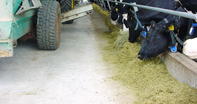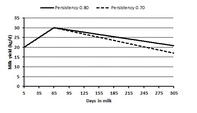It is important for new dairy farmers to understand a few of the basic principles of dairy farming. These principles explain why specific management actions are required to ensure a financially sustainable business.

Because dairy cows are the production units of a dairy herd, lactating cows would be the first animals to be bought for a new dairy. In this way, immediate cash flow from milk sales is provided. The ideal dairy herd has dry cows as well as heifers of different ages to ensure continued production and herd growth.
The Digestive System of a Dairy Cow
Dairy cows are ruminants and have a unique digestive system. Ruminants - e.g. cows, goats, sheep - eat and digest plant-based feeds such as grass.
Digestion in ruminants occurs in a four-chambered stomach. This enables them to utilize forages, like hays, silages, pastures and straw, i.e. feeds not generally consumed by humans. The four-chamber ruminant stomach consists of the reticulum, rumen, omasum and abomasum. These four compartments function as a single unit.
The rumen of about 160 litres makes up 80% of the ruminant’s stomach. It is essentially a fermentation vat containing large numbers of anaerobic bacteria (bacteria living in the absence of oxygen), protozoa, and other organisms live in symbiosis with the dairy cow (symbiosis is a close biological interaction between two different biological organisms).
These organisms digest the feed, which in turn provide energy and protein to cows to produce milk. When bacteria die off later in the abomasum, it serves as bacterial protein for the cow.
A healthy rumen depends on a sufficient amount of forages (grass from pastures as well as roughage) in the daily diet.
However, because the energy and protein content of forages is low, concentrated feeds such as grains (maize, wheat, barley or oats), and protein sources (fish meal, cottonseed-oil cake meal, or soybean meal) are fed to increase the milk yield of cows. These feeds are usually combined with minerals and salt in a concentrated mixture or dairy meal.
The Milk Yield of Dairy Cows

To start a lactation period (to produce milk), cows must calve down (give birth). Bull (male) and heifer (female) calves are born from this. Bull calves are usually culled early in life for their meat (calf meat is classified as ‘veal’ when the carcass weight is 100 kg or under) or can be grown out for beef production except when they are raised for breeding purposes.
Heifer calves are required to replace cows culled from the herd. Heifers are reared to reach first calving at about 24 months of age. Reducing the age of first calving reduces rearing cost.
This cost of heifers is recovered during the following milk production phases or lactation periods. Heifers can also be sold at prices higher than their rearing cost. The milk yield of dairy cows depends on their genetic merit and environmental factors such as the quality of their feed - which has the largest effect.
The daily milk yield of cows follows a distinct pattern. After calving, milk yield increases, reaching a peak at six to eight weeks after calving. After the peak, the high milk yield level is maintained after which it slowly declines with advancing lactation stage or days after calving. The reduction in daily milk yield after the peak is an indication of the persistence of milk production.
Persistence in milk production is described as a ratio, for example: milk production on day 240 (15 liters) compared to milk production on day 60 (20 liters) – for example 15 liter/30 liter = 30% or 20 liter/30 liter = 67%. The higher the ratio (e.g. 67%), the better is the persistence of milk production.
The decline in milk yield is affected by both the cow’s feeding programme and her genetic merit. The amount of milk produced over the lactation period is a combined effect of her peak milk yield and persistence of milk production after the peak.
The productive lifetime (all days in milk) of cows determines their lifetime profit margin. The amount of milk a cow produces after her first calf gives a good indication of how much milk she would be able to produce in her lifetime. So this could be a good indicator to decide on when buying a cow.
After calving, cows are usually in milk for about 300 days, after which they are dried off to prepare for the next lactation. When it is difficult to get cows pregnant, they may be in milk for longer than 300 days; however, they should be dried off at least 50-60 days before the next expected calving date.
By Dr Carel Muller